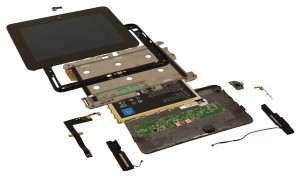When the original Kindle Fire was introduced, it was a huge shock to see such a powerful device offered for so little money. It was literally the device that changed the Android tablet market. A year later it’s no shock to see brand new 7” devices going for around $199. Are we still getting the same sort of value for that hardware price, though? An IHS iSuppli teardown team has looked into the components in details to give us an idea about exactly that.
What they have managed to determine is that while Amazon may not be subsidizing the Kindle Fire HD as they are suspected to have done with the first run of the Kindle Fire, it is still not a big money maker at the time of initial sales. This fits with a previous assertion by Jeff Bezos that the tablet is sold at cost.

Because they were planning to make any real profits off of digital content sales down the line, the Kindle Fire didn’t need to make money right away. The first teardowns estimated that it cost anywhere from $187-202 in materials alone per device. Factoring in the development costs and other miscellaneous expenses means that there was little chance of breaking even on a $199 sale.
This newest teardown indicates that the Kindle Fire HD is composed of about $165 worth of material. The major components come from LG Display, Texas Instruments, and Samsung. Basically we’re looking at a more advanced device built by a more established name in tablets for less money.
That might explain why the ability to remove the Special Offers on these devices was added so quickly after protests and made so cheap. If it’s not losing money then there is no good reason to force the ad subsidy.
While it does appear that Amazon might be making at least small profits on the Kindle Fire HD now, they’re not exactly trying to turn it into a major revenue stream. Consider the competition. Similar teardowns of the Google Nexus 7 and iPad Mini show material costs of $152 and $188 respectively. If we’re ignoring after-purchase digital sales entirely, Amazon and Google are making less than $50 per tablet they sell compared to Apple’s $140 with Amazon bringing in the least of the three.
All told, it’s safe to claim that Amazon is still offering great value for the money on the Kindle Fire HD. You can’t necessarily equate the cost of components to the quality of the hardware, but it’s not a completely worthless indication either. Amazon’s ability to sell their hardware at cost will continue to make it more difficult for newcomers without their own ecosystems to break into the affordable tablet market, but for the moment it is good for the customer. The industry is hardly likely to stagnate with Apple, Amazon, and Google all fighting to get the lion’s share of small tablet sales.